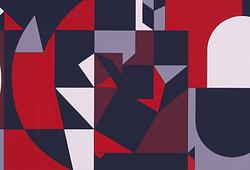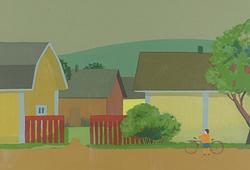Leander Engström
"Strålknippet över staden (Solnedgång över Gränna)" [Rays of light over the city/Sunset over Gränna, Sweden]
Signed Leander Engström. Executed in 1913. Oil on canvas 53 x 68 cm.
Provenance
The collections of Consul general Jean Jahnsson; Svensk-Franska Konstgalleriet, Stockholm, "IV:de konstauktion. Jean Jahnssons samlingar", March 14-16 1934, lot 24 (under the title "Norrländsk stad"); Physician Harald Nilsonne, Stockholm; Dr O Stern; Artist Eigil Schwab, Stockholm; Bukowski Auktioner AB, Stockholm, Sale 476, November 27 1990, lot 78; private collection; Bukowski Auktioner AB, Stockholm, Sale 555, "Vårens Moderna", May 4-7 2010, lot 89; Rolf Schmitz Collection.
Exhibitions
Liljevalchs Konsthall (Liljevalchs Public Art Gallery), Stockholm, "Samlarnas utställning. Svensk nutida konst 1906-1936", January 23 - February 17 1937; Liljevalchs Konsthall (Liljevalchs Public Art Gallery), Stockholm, "Svensk Konstkavalkad. Jubileumsutställning 1916-1956", September 21 - October 21 1956.
Literature
Hans-Olof Boström, Åke Fant and Dag Widman, "Leander Engström", 1986, mentioned and illustrated p. 32.
More information
.
Artist
Per leander Engström was a Swedish visual artist born in Ytterhogdal. He studied under the tutorship of Henri Matisse in Paris and the artists association school in Stockholm. Engström was part of the artistic group De Unga together with none other than Isaac Grünewald and Tor Bjurström. Engström was greatly inspired by Paul Gauguin, Vincent van Gogh and Paul Cézanne. Leander Engström followed in Osslund's footsteps and was captivated by Lapland's overwhelming natural scenery, which he depicted using the forms and colors of Fauvism. His paintings from 1912-15 - landscapes, still lifes, nude scenes - are harmonious and emotional, built upon Cézannes principles of discrete, weak colours. The years between 1916 and 1919 kan be understood as his most expressionistic period. Sweeping lines, large stylised planes and bright strong colours dominated his characteristic style. Engström found himself in Italy between 1920 and 1922 where he studied the early Rennaissance; it was during this time that he neared new objectivity. Leander Engström was one of Matisse's most impressive pupils.
Read more

























![Leander Engström, "Strålknippet över staden (Solnedgång över Gränna)" [Rays of light over the city/Sunset over Gränna, Sweden].](https://d3tj81smxskx4e.cloudfront.net/f-KwdMDIo6jWAUNbamaNpK-vrxVzkup8kC7DXJTVtgM/s:768:768/rt:fit/sm:1/scp:1/q:75/fn:1061228-11250055_fullscreen/czM6Ly9hdWt0aW9u/LXByb2R1Y3Rpb24v/aXRlbV9pbWFnZXMv/MTA2MTIyOC8xMTI1/MDA1NV9vcmlnaW5h/bC5qcGc)
![Leander Engström, "Strålknippet över staden (Solnedgång över Gränna)" [Rays of light over the city/Sunset over Gränna, Sweden].](https://d3tj81smxskx4e.cloudfront.net/KC0aOrVx79iBgCP3Wck9u5Mi2v3q3kTHvW6vB05d5OU/s:2000:2000/rt:fit/sm:1/scp:1/q:75/fn:1061228-11250055_fullsize/czM6Ly9hdWt0aW9u/LXByb2R1Y3Rpb24v/aXRlbV9pbWFnZXMv/MTA2MTIyOC8xMTI1/MDA1NV9vcmlnaW5h/bC5qcGc)
![Leander Engström, "Strålknippet över staden (Solnedgång över Gränna)" [Rays of light over the city/Sunset over Gränna, Sweden].](https://d3tj81smxskx4e.cloudfront.net/9ZKHHg-9hrR5971FllvgrdswdWpip5PnACOFPg5_AFo/s:768:768/rt:fit/sm:1/scp:1/q:75/fn:1061228-11250066_fullscreen/czM6Ly9hdWt0aW9u/LXByb2R1Y3Rpb24v/aXRlbV9pbWFnZXMv/MTA2MTIyOC8xMTI1/MDA2Nl9vcmlnaW5h/bC5qcGc)
![Leander Engström, "Strålknippet över staden (Solnedgång över Gränna)" [Rays of light over the city/Sunset over Gränna, Sweden].](https://d3tj81smxskx4e.cloudfront.net/j7qDE0ObZBvViLbTrXxYQqOuh2aiZOl5FLzDdU68z0M/s:2000:2000/rt:fit/sm:1/scp:1/q:75/fn:1061228-11250066_fullsize/czM6Ly9hdWt0aW9u/LXByb2R1Y3Rpb24v/aXRlbV9pbWFnZXMv/MTA2MTIyOC8xMTI1/MDA2Nl9vcmlnaW5h/bC5qcGc)
![Leander Engström, "Strålknippet över staden (Solnedgång över Gränna)" [Rays of light over the city/Sunset over Gränna, Sweden].](https://d3tj81smxskx4e.cloudfront.net/yWHpIWRgxfGeE-IYKPcwOS2O7kvfh0C-SRKlXOEEKVI/s:768:768/rt:fit/sm:1/scp:1/q:75/fn:1061228-11250067_fullscreen/czM6Ly9hdWt0aW9u/LXByb2R1Y3Rpb24v/aXRlbV9pbWFnZXMv/MTA2MTIyOC8xMTI1/MDA2N19vcmlnaW5h/bC5qcGc)
![Leander Engström, "Strålknippet över staden (Solnedgång över Gränna)" [Rays of light over the city/Sunset over Gränna, Sweden].](https://d3tj81smxskx4e.cloudfront.net/gXrg_SBIpHY2BVVqTxHVRpVHSPL44YY1Y9R1uqPDo-c/s:2000:2000/rt:fit/sm:1/scp:1/q:75/fn:1061228-11250067_fullsize/czM6Ly9hdWt0aW9u/LXByb2R1Y3Rpb24v/aXRlbV9pbWFnZXMv/MTA2MTIyOC8xMTI1/MDA2N19vcmlnaW5h/bC5qcGc)
![Leander Engström, "Strålknippet över staden (Solnedgång över Gränna)" [Rays of light over the city/Sunset over Gränna, Sweden].](https://d3tj81smxskx4e.cloudfront.net/fBo-KcBYj2Dt9Coz189DKIrwatmQJKIkH6aphZUV3Xo/s:768:768/rt:fit/sm:1/scp:1/q:75/fn:1061228-11250068_fullscreen/czM6Ly9hdWt0aW9u/LXByb2R1Y3Rpb24v/aXRlbV9pbWFnZXMv/MTA2MTIyOC8xMTI1/MDA2OF9vcmlnaW5h/bC5qcGc)
![Leander Engström, "Strålknippet över staden (Solnedgång över Gränna)" [Rays of light over the city/Sunset over Gränna, Sweden].](https://d3tj81smxskx4e.cloudfront.net/iHwODshQG4rUu_B-YdulE_4GFSGR9-HlXsZxKpcTGjA/s:2000:2000/rt:fit/sm:1/scp:1/q:75/fn:1061228-11250068_fullsize/czM6Ly9hdWt0aW9u/LXByb2R1Y3Rpb24v/aXRlbV9pbWFnZXMv/MTA2MTIyOC8xMTI1/MDA2OF9vcmlnaW5h/bC5qcGc)
![Leander Engström, "Strålknippet över staden (Solnedgång över Gränna)" [Rays of light over the city/Sunset over Gränna, Sweden].](https://d3tj81smxskx4e.cloudfront.net/qs1PGKyDt9yKWVMscDJngjzrf9uPJrgfG1-GKzwzenM/s:350:350/rt:fit/sm:1/scp:1/q:75/fn:1061228-11250055_object/czM6Ly9hdWt0aW9u/LXByb2R1Y3Rpb24v/aXRlbV9pbWFnZXMv/MTA2MTIyOC8xMTI1/MDA1NV9vcmlnaW5h/bC5qcGc)
![Leander Engström, "Strålknippet över staden (Solnedgång över Gränna)" [Rays of light over the city/Sunset over Gränna, Sweden].](https://d3tj81smxskx4e.cloudfront.net/y-Qt9IUErFJ5MXanhkKNZzzR0YMt36V1BT-vxNaONPg/s:350:350/rt:fit/sm:1/scp:1/q:75/fn:1061228-11250066_object/czM6Ly9hdWt0aW9u/LXByb2R1Y3Rpb24v/aXRlbV9pbWFnZXMv/MTA2MTIyOC8xMTI1/MDA2Nl9vcmlnaW5h/bC5qcGc)
![Leander Engström, "Strålknippet över staden (Solnedgång över Gränna)" [Rays of light over the city/Sunset over Gränna, Sweden].](https://d3tj81smxskx4e.cloudfront.net/xEn4zoQKa-bxOHvFwVkRsYNtGLsN_OW1CRdg1biQgpU/s:350:350/rt:fit/sm:1/scp:1/q:75/fn:1061228-11250067_object/czM6Ly9hdWt0aW9u/LXByb2R1Y3Rpb24v/aXRlbV9pbWFnZXMv/MTA2MTIyOC8xMTI1/MDA2N19vcmlnaW5h/bC5qcGc)
![Leander Engström, "Strålknippet över staden (Solnedgång över Gränna)" [Rays of light over the city/Sunset over Gränna, Sweden].](https://d3tj81smxskx4e.cloudfront.net/1SJ7ymZfz1kQwcLvwv2cjvaLTwJ6NFry54ArOcnI7uo/s:350:350/rt:fit/sm:1/scp:1/q:75/fn:1061228-11250068_object/czM6Ly9hdWt0aW9u/LXByb2R1Y3Rpb24v/aXRlbV9pbWFnZXMv/MTA2MTIyOC8xMTI1/MDA2OF9vcmlnaW5h/bC5qcGc)
